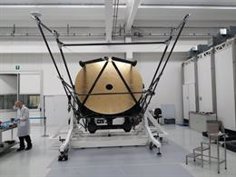A 3D model of the Orion Nebula shows the Orion Veil layer as a bluish gas surrounding the nebula depicted in red and yellow. – NASA, ESA, FRANK SUMMERS (STSCI)
July 15 () –
The SOFIA airborne telescope has discovered that Orion’s Veil, an expanding layer of dust and gas in front of the massive star cluster in the Orion Nebula, it could be breaking.
Within the Orion Nebula is a massive cluster of stars known as the Trapezium stars. Winds from the Trapezium stars blow a bubble of dust and gas into the area in front of them, called Orion’s Veil. Most of Orion’s Veil is thin, and most of its gas is in the wall of the bubble.
The wall, or shell, of Orion’s Veil is one light-year thick and is expanding toward us, and recent observations from SOFIA’s (Stratospheric Observatory for Infrared Astronomy) GREAT (German REceiver for Astronomy at Terahertz Frequencies) instrument have identified some unexpected features in it.
“The bubble, with a diameter of about seven light-years, should be an almost spherical structure, but we found a bulge in its northwestern part,” he said. it’s a statement Ümit Kavak, a SOFIA postdoctoral researcher based at NASA Ames Research Center, lead author of a recent paper in Astronomy & Astrophysics describing the studies.
SOFIA observations show the emission of ionized carbon in this bulge, which Kavak used to determine its size, structure, and how it is expanding, in hopes of discovering its origins and future.
Shaped like a “U” lying on its side, the bulge extends well beyond the shell of Orion’s Veil. It’s a likely place for the shell to pierce, and the bulge’s chimney-shaped top seems to imply that it has already done so.

“When you break through the shell of the Veil, you effectively start stirring up a cosmic soup of gas and dust by adding turbulence,” Kavak said.
“This is not the most appetizing soup, but it is one of the ways to form new stars or limit future star formation,” added Alexander Tielens, a researcher at Leiden University and co-author of the paper.
This turbulence affects the density, temperature, and chemistry of its surrounding region, which can ultimately lead to the creation or destruction of star-forming sites.
The group also identified a second, fainter bulge, which they plan to investigate further in a future publication. Together, these bulges affect the entire morphology of the Orion Nebula.






![[Img #74662]](https://thelatestnews.world/wp-content/uploads/2024/12/Organisms-with-the-shortest-life-150x150.jpg)





![[Img #74662]](https://thelatestnews.world/wp-content/uploads/2024/12/Organisms-with-the-shortest-life-300x200.jpg)


Add Comment